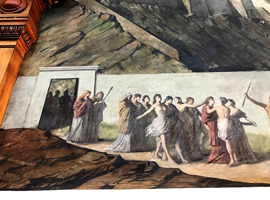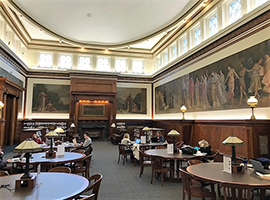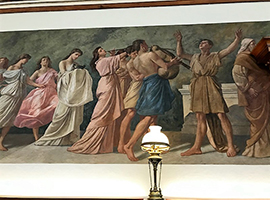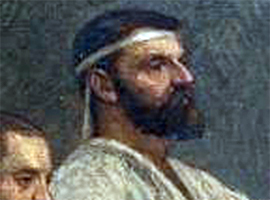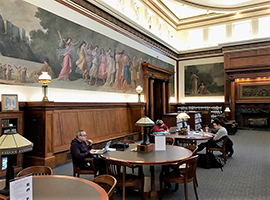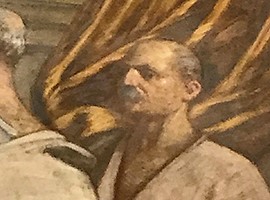



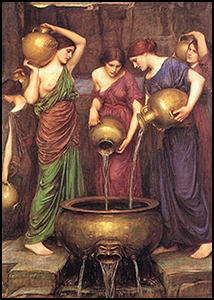
After Tommaso Juglaris was tapped by former student Henry Hammond Gallison to paint a series of murals for the Reading Room of a new building housing the nation’s oldest public library in Franklin, Massachusetts, he set to work considering possible subjects. Initially, Juglaris recommended a mural cycle based on the biblical story of the Prodigal Son. When this was rejected by his patrons, he proposed the mythological stories of Atalanta and the Danaids as parallel mural themes. Juglaris prepared large colored drawings to support this idea.
Greek mythology was certainly more in keeping with the architecture of the splendid new library building, intended to authentically replicate a Greek temple. In addition, the tale of fleet-footed Atalanta and her suitors has always been popular. Likewise, the Danaids have perennially piqued interest. In Western painting and sculpture they had already been rather famously depicted by Martin Johann Schmidt (1785), Abel de Pujol (1836), Hector LeRoux (1877), John Reinhard Weguelin (1878), and Auguste Rodin (1889).
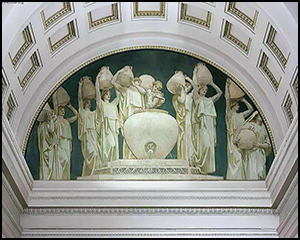
Juglaris’s contemplated scheme for the Franklin Public Library drew the support of art critics privileged to view it. Regarding both of his proposed scenes as an improvement over Edwin Abbey’s Holy Grail mural for the Boston Public Library, for instance, the Boston Globe noted that “in magnitude and conception” they represented “one of the most extensive and ambitious works yet undertaken in this country, and, when completed, will form, with the conceptual scheme of the building the most consistent decorative accomplishment that has been attempted” in the United States. Similarly, full of praise, the art critic for the Democrat and Chronicle in Rochester, New York observed that the “structural scheme of the [Franklin Library] building is pure Greek and the mural decorations are of Greek subjects.” “This treatment,” he added, “assures unity, something that is lacking in the Boston Public Library.”
Yet after reviewing the Juglaris’s preliminary drawings Gallison and his patrons vetoed his second proposal too. A nationally syndicated newspaper article that appeared in Scranton, Pennsylvania, as well as Boston, reported that they wanted more figures. At the same time, Gallison and the Ray family may actually have taken exception to the Danaids themselves. According to Greek myth, the Danaids were the fifty daughters of Danaus forced to wed the fifty sons of their father’s twin brother and enemy, Aegyptus. On their wedding night, all but one bride kills her cousin-bridegroom with a dagger. For their crime the forty-nine Danaids are sentenced by Zeus to perpetually carry water through the underworld in a leaking jug. This veto of subject matter for Juglaris had an ironic twist. In 1903 and 1906, the English pre-Raphaelite painter John William Waterhouse unveiled two celebrated paintings of the Danaids. Moreover, two decades later, a Juglaris rival, John Singer Sargent, opted for the same story in completing a large lunette or half-moon mural installed at the head of the grand staircase of the Boston Museum of Fine Arts. There, as Museum historian Walter Muir Whitehill rather archly notes, “Ziegfeld Chorus girls, disguised as Danaides, pour water into a great vase-shaped fountain.”
Ultimately, Juglaris received approval to paint at Franklin a civic ceremony entitled Grecian Festival inspired by Greco-Roman Bacchanalia and Saturnalia festivals. These ancient festivals originally served as a time of wild revelry, but they were later tamed through Roman legislation. During the festival celebrations, women and men played equally prominent roles and all class distinctions were suspended. Lending a democratic air to the festivities, plebeians and patricians freely mingled. And, for a precious moment, slaves were allowed to act as free men and women.
As conceived by Juglaris, Grecian Festival is a series of sequential scenes. In wrapping his 240-foot-long twelve-foot-high mural around four walls of the Reading Room, Juglaris immediately faced two major artistic challenges. First he had to take into consideration a massive fireplace and three colonnaded reading room entrances. Second, he had to make the most of a strong horizontal wall space. Juglaris chose to treat the architectural features of the Reading Room as if they were an intrinsic part of the foreground of the mural itself, inviting the viewer to look past them. Simultaneously, he developed a highly linear composition through the use of background landscape. Groupings human figures add depth, perspective, and balance, creating various focal points to engage the interest of viewers and draw them into the sweep of the mural’s story. Juglaris used the shorter expanses of the Reading Room’s east and west walls for four scenes involving preparations for the festival.

On opposite sides of the Reading Room, flanking the east wall entrance and west wall fireplace, two or three women tend a sacred fire, carry sacred offerings, or bear festal wine, while a high priest enters the temple portico. Meanwhile, the much longer south wall, flanked with Doric-style entrances near both ends, depicts the predawn departure of a procession from the city gates and its winding passage through a temple grove. Somber priests, heads barely visible above an entrance pediment; full-bodied musicians bent slightly back as they blow their bagpipes and horns; dancers already alight to the music—all are part of the throng in route to the temple ceremony.
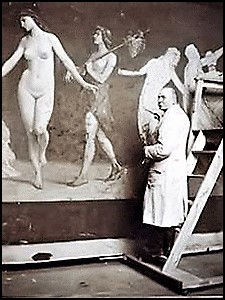
Directly across the Reading Room on the north wall, the festival participants arrive at the temple, greeted by the enthroned high priest and his male and female assistants who have readied a lamb for sacrifice before a smoking sacred fire. As a master of ceremonies signals the start of the sacred rites, and offerings are brought forth to honor the city’s patron deity, the musicians once again play and the dancers, responding together, form a swirling Dionysian circle.
Without becoming formulaic, the mural describes a more-or-less symmetrical parabola around the room, creatively using the long, horizontal space at hand. As the procession moves along the south and north walls from its start at the city gates to its culmination before the enthroned high priest, it shifts into the foreground, approaching the viewer with larger figures, then partly recedes.
Occupying middle-to-high ground at the end of the mural, the high priest, surrounded by his personal entourage, greets the procession at a distance appropriate for majesty and authority. At the same time, the actions and arrangements of those in the procession create symmetrical points and counterpoints. On the south wall the upraised hands of a man directing the musicians are matched by the uplifted hands of a woman following the dancers, beating time. Likewise, on the north wall a hand raised high by a priestess near the foot of the high priest’s throne is met by the upraised staff of the just-arrived master of ceremonies, as well as the deferential salute of his assistant. Throughout the mural, figures pause to look back at their companions or join hands with them, defining small groups that attract the viewer’s eye.
Grecian Festival gave Juglaris wide opportunity to display his talent for figural drawing. More than sixty figures appear on the Reading Room walls. Although the mural cycle incudes a distant acropolis and classical columns, as well as mountains and foliage, these elements are only vaguely rendered. Beyond serving as masses to balance the overall composition, they provide a muted backdrop for Juglaris’s bare-limbed or seminude figures, often subtly draped in delicate tints or cheerful hues of white, cream, old rose, pink, violet, and golden yellow that add to the gracefulness of their forms. Breaking with strictly classical tradition, Juglaris devotes great care to the individuality of each figure. In their detail, several of them—most notably the head musician, the chief dancer, and a bacchante, identifiable on the basis of a fawn skin cloak and a thyrsus staff topped with pine cones—stand out from the crowd. Nevertheless, in keeping with collectivity of a communal procession, Juglaris organizes most of his figures as ensemble groups.

In light of Boston’s longstanding claim to be the “Athens of America,” as well as the Greek architectural style of the Ray Memorial Library, the classicism of Juglaris’s Reading Room murals were intended to strike a chord with the local community. But his subject matter is also in tune with the spirit of the Progressive Era and the City Beautiful Movement, which encouraged the idea that aesthetically attractive towns and cities, along with well-decorated civic ceremonies and rituals, could be instrumental in fostering good citizenship. Meanwhile, at another level, Juglaris’s mural cycle, while far from revolutionary or groundbreaking, had a conceptual affinity with end-of-the-century painting and public pageantry that favored idyllic scenes. In the 1890s and early 1900s such bucolic panoramas served as a tacit critique of the more dehumanizing aspects of modern society. They were also regarded as therapeutic and spiritually restorative for a world-weary viewing public. While stylistically different, Puvis de Chavannes’s earlier mural at the Boston Public Library was executed in a similar idyllic mode.
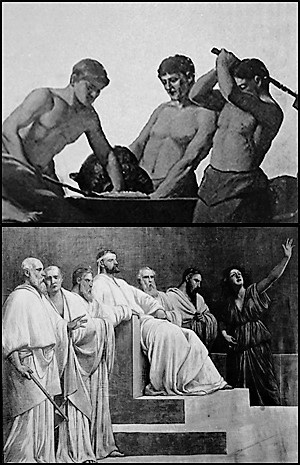
As Juglaris successfully developed the thematic content for Grecian Festival, the colossal size of his canvas posed a different set of technical issues for him. However, with his considerable experience as a muralist Juglaris proved adept at nimbly managing the logistics of another large-sized commission. If consistent with his practice elsewhere, Juglaris drew and painted the many figures of his mural cycle from live models. Immediate testimony to this fact is the insertion of his own self-portrait in a corner of the mural cycle as an onlooker to the festival procession. Likewise, the Franklin Public Library architect Theodore H. Skinner—as noted in a memoir by his daughter, Prudence Wayland Smith—was tapped as a model for the festival’s enthroned high priest. In an article entitled “Picture 240 Feet Long,” the Scranton Republican for October 27, 1902 vividly described the tactical aspects of the Franklin project: “The artist is at work in a studio some miles from Boston. Here he has a moveable scaffold which he slides along as the work grows. The canvas is wound upon a great upright reel and areas yet innocent of paint are unrolled from a corresponding reel on the other side of the room. The background of dark green leaves is rapidly painted in, and upon this background the artist sketches in crayon his figures. Then by having the aid of models he perfects the drawing and eventually applies the color…” As the Scranton Republican further noted, there would also be much final finish work for Juglaris to do. “The picture,” the newspaper explained, “will be set up in a large hall in Boston where the artist can see the whole thing together, and where he can give it some touches to promote unity, and then it will be rolled up and stored again until next spring. Mr. Juglaris will then return to this country, and will carefully retouch the work under the guidance of a cold eye. After the picture has received the final touches it will be exhibited in New York, Boston and perhaps elsewhere.”
As much as he relished the Franklin Library project, Juglaris found working under the tight deadline requested by his patrons and complicated by initial delays onerous. Reporting the artist’s frank sentiments, Scranton Republican noted that “Mr. Juglaris has been compelled to work with speed that he thinks is very unjust to himself and the picture he seeks to produce.” Whatever the stress involved, Juglaris was pleased with the Grecian Festival that emerged from his brush. As a finishing touch, Juglaris discreetly inserted his own self-portrait in the northwest corner of his Reading Room mural cycle, permitting him to forever stand as a proud witness to his vast and enthralling Grecian Festival.
As Juglaris neared the completion of Grecian Festival, his commission was further expanded to include a series of friezes for a Memorial Hall that served as the front entry for the Franklin Public Library. As his theme, he chose The Hours, inspired by the Horae, or Greek goddesses of the hours of the day.
All told, Juglaris’s The Hours includes five adjoining friezes, each framed in ornamental molding, extending around three sides of the 20 x 60-foot Memorial Hall. The two longest friezes, the Hours of Labor and the Hours of Sleep, decorate the Memorial Hall’s north and south side walls. Flanked by panels representing Morning and Evening, the Hours of Pleasure—also known as the Flying Hours—appear on high directly opposite the library’s main colonnaded entrance, greeting those who have come for personal pleasure, leisure, and edification.

Reporting on Juglaris’s second commission at Franklin, apparently after reviewing the artist’s own preliminary sketches, the New York Times described the allegorical Hours of Pleasure and its companion panels, Morning and Evening, as a “large mural painting,” adding: “Eight partly draped figures of the Hours are swinging hand in hand through the air against a backdrop of gold. Another panel shows Morning attended by Prudence with her mirror, the Morning Star with a star on her forehead, and Fortune with her wheel. Dawn flies before the chariot of Morning, dripping dew from a jar. On the other side will be Evening in the chariot of the moon with black horses, followed by two figures, bearing an olive branch, the other, a draped female figure of Vendetta, clutching a dagger. On the right of this panel are peasants returning from labor.”
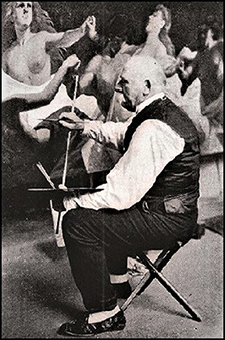
After the full installation of The Hours, critic Irene Sargent, writing for Gustav Stickley’s well-known The Craftsman magazine, lauded the “beautiful lines,” compositional balance, and “mosaic or bouquet of color” of the Franklin friezes, which offered themselves as “a study in chiaroscuro.” Typical was Sargent’s appreciation for Juglaris’s Morning: “Here, the dark sinister figure of the ‘cruel goddess’ Fortune plays an important role; since it adds weight to the compact mass at the right which is necessary to balance the freer, more diffuse group on the opposite side. Then, owing to the separation of the two groups naturally affected by the chariot, two fine, irregular sweeping lines are produced, curving downward, and leaving much open space; while the upper portion of the background is made sufficiently interesting by the outstretched arms and wings, and the attributes of the figures.” Adding to the exuberance of the five frieze panels was Juglaris’s choice of vivid jewel-tone colors for the flowing capes and gowns of his many allegorical figures—red, green, rose, yellow, violet, turquoise, and sapphire-blue—all in relief against lustrous gold backgrounds.
Juglaris’s choice of The Hours as the subject of his friezes for the Memorial Hall of the Franklin Public Library may have been inspired by contemporaneous events. At the turn of the twentieth century, laborers were agitating for an eight-hour work day that would also assure them of adequate time for sleep and rejuvenating leisure. Amid its imagery and symbolism, The Hours appeals to the ideal of work-life balance—still an important concern today. Together, Juglaris’s murals and friezes offer a pleasing vision of civic cooperation and harmony, grounded in a life of thoughtful contemplation and well-ordered creativity. They suit their location well: they are a fitting decoration for a public building dedicated overall to fostering the well-being of citizens and cultivating an informed democratic society.
